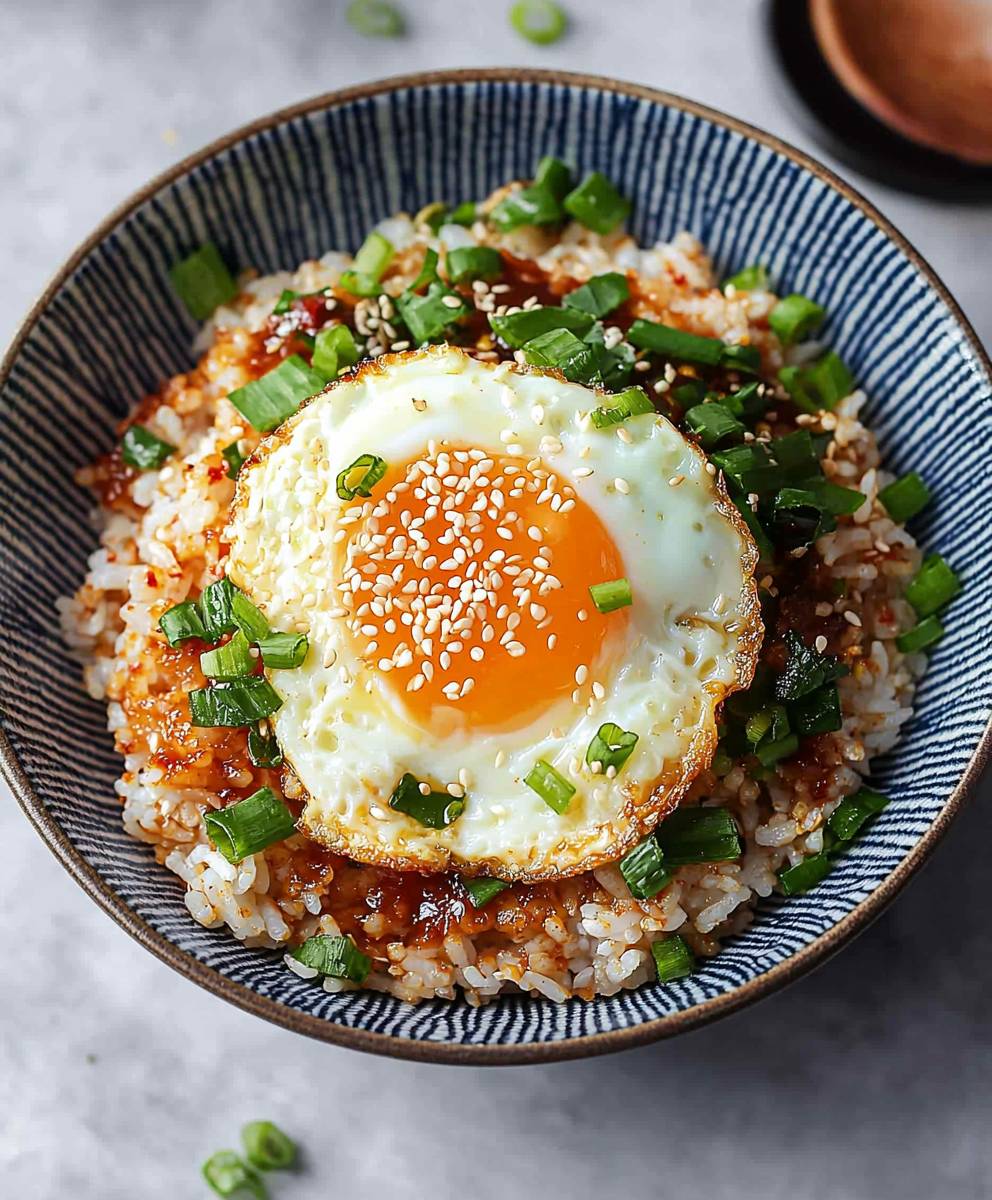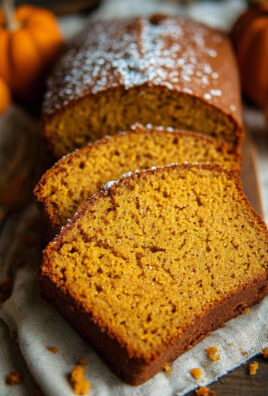Korean Egg Rice, or Gyeran Bap, is more than just a quick meal; it’s a warm hug in a bowl, ready in minutes! Have you ever craved something comforting, flavorful, and incredibly easy to make after a long day? This is it. Forget complicated recipes and hours in the kitchen; this simple dish delivers maximum satisfaction with minimal effort.
While its exact origins are humble, Korean Egg Rice has become a beloved staple in Korean households, particularly among students and busy professionals. It’s the kind of dish that grandmothers make for their grandchildren, a symbol of love and care passed down through generations. Think of it as the Korean equivalent of mac and cheese – a go-to comfort food that evokes feelings of nostalgia and warmth.
What makes Gyeran Bap so irresistible? It’s the perfect combination of fluffy rice, savory soy sauce, nutty sesame oil, and the richness of a perfectly cooked egg. The creamy yolk coats every grain of rice, creating a symphony of flavors and textures that dance on your palate. It’s quick, affordable, and endlessly customizable – you can add kimchi, vegetables, or even a sprinkle of seaweed for an extra layer of flavor. Trust me, once you try this, it will become a regular in your rotation!
Ingredients:
- For the Rice:
- 2 cups cooked short-grain rice (preferably day-old for better texture)
- 1 tablespoon sesame oil
- 1/2 teaspoon salt
- 1/4 teaspoon ground white pepper (optional)
- For the Eggs:
- 4 large eggs
- 1 tablespoon milk or water
- 1/4 teaspoon salt
- 1/8 teaspoon black pepper
- 1 tablespoon vegetable oil (for cooking the eggs)
- For the Sauce:
- 2 tablespoons soy sauce
- 1 tablespoon sesame oil
- 1 tablespoon rice vinegar
- 1 teaspoon sugar
- 1/2 teaspoon gochugaru (Korean chili flakes, adjust to taste)
- 1/2 teaspoon minced garlic
- 1/4 teaspoon sesame seeds
- Toppings (Optional):
- Kimchi, chopped
- Roasted seaweed flakes (gim)
- Green onions, thinly sliced
- Sesame seeds
- Fried egg (additional, for extra protein)
- Spicy mayonnaise (gochujang mayo)
Preparing the Rice
- Fluff the Rice: If you’re using freshly cooked rice, gently fluff it with a fork to separate the grains. Day-old rice works best because it’s less sticky and will absorb the sesame oil better.
- Season the Rice: In a large bowl, combine the cooked rice, sesame oil, salt, and white pepper (if using). Mix well until all the rice is evenly coated. This step is crucial for adding flavor and preventing the rice from clumping together. I like to use my hands to gently massage the seasoning into the rice, but a spatula works just fine too.
- Set Aside: Cover the bowl with a damp paper towel or plastic wrap to keep the rice warm and prevent it from drying out while you prepare the other components.
Making the Egg Mixture
- Whisk the Eggs: In a medium bowl, crack the eggs. Add the milk or water, salt, and black pepper. Whisk vigorously until the eggs are light and frothy. This incorporates air into the eggs, resulting in a softer and fluffier texture when cooked. Make sure there are no visible streaks of egg white.
- Prepare Your Pan: Heat the vegetable oil in a non-stick skillet over medium heat. The pan should be hot enough that a drop of egg mixture sizzles gently. A well-seasoned cast iron skillet also works great.
Cooking the Eggs
- Pour in the Egg Mixture: Once the oil is heated, pour the egg mixture into the skillet.
- Scramble Gently: Let the eggs cook undisturbed for a few seconds until a thin layer sets on the bottom. Then, using a spatula, gently push the cooked egg towards the center of the pan, allowing the uncooked egg to flow underneath. Continue this process until the eggs are mostly cooked but still slightly moist. You want them to be soft and creamy, not dry and rubbery.
- Remove from Heat: Take the skillet off the heat. The residual heat will continue to cook the eggs slightly.
- Break into Pieces: Use your spatula to break the scrambled eggs into bite-sized pieces. Don’t over-mix; you want some larger, softer curds.
Preparing the Sauce
- Combine Ingredients: In a small bowl, whisk together the soy sauce, sesame oil, rice vinegar, sugar, gochugaru, minced garlic, and sesame seeds.
- Taste and Adjust: Taste the sauce and adjust the ingredients to your liking. If you prefer a sweeter sauce, add a little more sugar. For a spicier sauce, add more gochugaru. If you want it tangier, add a touch more rice vinegar.
Assembling the Korean Egg Rice
- Portion the Rice: Divide the seasoned rice into bowls. I usually aim for about one cup of rice per serving, but adjust according to your appetite.
- Top with Eggs: Spoon the scrambled eggs over the rice. Be generous with the eggs!
- Drizzle with Sauce: Drizzle the prepared sauce over the eggs and rice. Again, adjust the amount of sauce to your preference. I like a good amount of sauce to coat everything nicely.
- Add Toppings: Sprinkle with your desired toppings. Kimchi, roasted seaweed flakes, green onions, and sesame seeds are all excellent choices. A fried egg on top adds extra richness and protein. A drizzle of spicy mayonnaise (gochujang mayo) can also add a delicious kick.
- Serve Immediately: Serve the Korean egg rice immediately while the rice and eggs are still warm.
Tips and Variations
- Rice Choice: While short-grain rice is traditional, you can use other types of rice if that’s what you have on hand. Just be aware that the texture and flavor will be slightly different. Brown rice can be a healthier alternative.
- Egg Cooking Style: Some people prefer to make a thin omelet and then slice it into strips to top the rice. This is another great option if you prefer a more structured egg presentation.
- Protein Additions: Feel free to add other protein sources to your Korean egg rice. Bulgogi (Korean BBQ beef), shredded chicken, or tofu are all excellent choices.
- Vegetable Variations: Add some chopped vegetables to the egg mixture or as toppings. Spinach, mushrooms, carrots, and zucchini are all good options.
- Spice Level: Adjust the amount of gochugaru in the sauce to control the spice level. If you’re sensitive to spice, start with a small amount and add more to taste. You can also use gochujang (Korean chili paste) in the sauce for a deeper, more complex flavor.
- Make it Vegan: To make this dish vegan, use a plant-based egg substitute and ensure your soy sauce and kimchi are vegan-friendly.
- Leftovers: Leftovers can be stored in the refrigerator for up to 2 days. Reheat gently in the microwave or on the stovetop. The rice may dry out slightly, so you may want to add a splash of water or broth when reheating.
Why This Recipe Works
This Korean egg rice recipe is a winner because it’s quick, easy, and incredibly flavorful. The combination of the savory rice, creamy eggs, and tangy-spicy sauce is simply irresistible. It’s a perfect weeknight meal when you’re short on time but still want something satisfying and delicious. The customizable toppings allow you to tailor the dish to your own preferences, making it a versatile and endlessly adaptable recipe. Plus, it’s a great way to use up leftover rice!
Serving Suggestions
Korean egg rice is delicious on its own, but it also pairs well with other Korean side dishes (banchan). Consider serving it with:
- Kimchi (of course!)
- Korean cucumber salad (oi muchim)
- Spinach salad (sigeumchi namul)
- Bean sprout salad (kongnamul muchim)
- Pickled radish (danmuji)
A simple bowl of miso soup or a side of grilled vegetables would also complement the dish nicely.
Enjoy!
I hope you enjoy this Korean egg rice recipe as much as I do! It’s a staple in my kitchen, and I’m sure it will become one of your favorites too. Don’t be afraid to experiment with different toppings and variations to create your own unique version. Happy cooking!

Conclusion:
So there you have it! This Korean egg rice recipe is more than just a quick meal; it’s a flavor explosion in a bowl, a comforting hug on a plate, and a testament to how simple ingredients can create something truly extraordinary. I genuinely believe this is a must-try for anyone looking for a delicious, easy, and satisfying dish. The combination of the fluffy rice, the savory-sweet egg mixture, and the burst of flavor from the sesame oil and green onions is simply irresistible.
Why is this Korean egg rice a must-try? Because it’s incredibly versatile! It’s perfect for a busy weeknight dinner when you’re short on time but don’t want to compromise on taste. It’s also a fantastic option for a quick and easy lunch. And honestly, it’s even good enough to serve to guests as a side dish or a light meal. The beauty of this recipe lies in its simplicity and adaptability.
But the fun doesn’t stop there! Feel free to experiment with different variations to make it your own. Want to add a little heat? A sprinkle of gochugaru (Korean chili flakes) will do the trick. Craving some protein? Toss in some cooked ground beef, shredded chicken, or even some pan-fried tofu. For a vegetarian option, consider adding some sautéed mushrooms or spinach. You could also try different types of rice, like brown rice or even quinoa, for a healthier twist.
Serving suggestions? I love to serve this Korean egg rice with a side of kimchi for that extra kick of fermented goodness. A simple cucumber salad or some steamed broccoli would also be a great addition. And if you’re feeling fancy, you could even top it with a fried egg for an extra layer of richness. Another great option is to add a dollop of gochujang (Korean chili paste) for a deeper, more complex flavor. The possibilities are endless!
Don’t be afraid to get creative and experiment with different toppings and seasonings. That’s the best part about cooking – making a recipe your own and discovering new flavor combinations that you love. I’ve tried countless variations myself, and I’m always amazed at how different each one can be.
I truly hope you give this Korean egg rice recipe a try. I’m confident that you’ll love it as much as I do. It’s a dish that I find myself making again and again, and I’m always excited to share it with others.
And now, for the most important part: I want to hear about your experience! Did you try the recipe? What variations did you make? What did you think? Please, share your thoughts and photos in the comments below. I’m always eager to learn from my readers and see how they’ve put their own spin on my recipes. Your feedback is invaluable, and it helps me to continue creating recipes that you’ll love. So, go ahead, get cooking, and let me know what you think! Happy cooking, and I can’t wait to hear from you!
Korean Egg Rice: A Quick & Delicious Recipe
Quick and easy Korean Egg Rice (Gyeran Bap) with savory rice, creamy eggs, and a tangy-spicy sauce. Customizable with your favorite toppings!
Ingredients
- 2 cups cooked short-grain rice (preferably day-old)
- 1 tablespoon sesame oil
- 1/2 teaspoon salt
- 1/4 teaspoon ground white pepper (optional)
- 4 large eggs
- 1 tablespoon milk or water
- 1/4 teaspoon salt
- 1/8 teaspoon black pepper
- 1 tablespoon vegetable oil
- 2 tablespoons soy sauce
- 1 tablespoon sesame oil
- 1 tablespoon rice vinegar
- 1 teaspoon sugar
- 1/2 teaspoon gochugaru (Korean chili flakes, adjust to taste)
- 1/2 teaspoon minced garlic
- 1/4 teaspoon sesame seeds
- Kimchi, chopped
- Roasted seaweed flakes (gim)
- Green onions, thinly sliced
- Sesame seeds
- Fried egg (additional)
- Spicy mayonnaise (gochujang mayo)
Instructions
- Prepare the Rice: If using freshly cooked rice, fluff it with a fork. In a large bowl, combine rice, sesame oil, salt, and white pepper (if using). Mix well. Cover to keep warm.
- Make the Egg Mixture: In a medium bowl, whisk eggs, milk/water, salt, and black pepper until frothy.
- Cook the Eggs: Heat vegetable oil in a non-stick skillet over medium heat. Pour in the egg mixture. Let set slightly, then gently push cooked egg towards the center, allowing uncooked egg to flow underneath. Cook until mostly cooked but still moist.
- Remove from Heat: Take the skillet off the heat. Break the scrambled eggs into bite-sized pieces.
- Prepare the Sauce: In a small bowl, whisk together soy sauce, sesame oil, rice vinegar, sugar, gochugaru, minced garlic, and sesame seeds. Taste and adjust to your liking.
- Assemble: Divide rice into bowls. Top with scrambled eggs. Drizzle with sauce. Add desired toppings.
- Serve: Serve immediately while warm.
Notes
- Rice Choice: Short-grain is traditional, but other rice types work.
- Egg Cooking Style: Can also make a thin omelet and slice it.
- Protein Additions: Bulgogi, shredded chicken, or tofu are great additions.
- Vegetable Variations: Add chopped vegetables to the egg mixture or as toppings.
- Spice Level: Adjust gochugaru to your preference.
- Vegan: Use plant-based egg substitute and vegan-friendly soy sauce and kimchi.
- Leftovers: Store in the refrigerator for up to 2 days. Reheat gently.





Leave a Comment